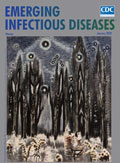
Volume 26, Number 1—January 2020
Letter
Vaccine Effectiveness against DS-1–Like Rotavirus Strains
On This Page
Downloads
Article Metrics
To the Editor: Global emergence of reassortant rotavirus A (RVA) strains possessing the DS-1 backbone genes, such as DS-1–like G1P[8] strains (1–3), raises 2 key questions of public health importance. First, is the G1P[8] monovalent vaccine (RV1) effective against the DS-1–like G1P[8] strain? Second, does this strain cause more severe disease than the Wa-like G1P[8] strain?
For the first question, Jere et al. (1) showed that RV1 was highly effective against DS-1–like G1P[8] RVAs (vaccine effectiveness [VE] 85.6% [95% CI 34.4%–96.8%]). For the second question, we conducted a study in Hanoi, Vietnam, during the 2012–2013 rotavirus season in which 20 DS-1–like G1P[8] RVAs co-circulated with 49 Wa-like G1P[8] RVAs and 50 G2P[4] RVAs among children <2 years of age who had diarrhea. We found no evidence of increased virulence of DS-1–like G1P[8] strains as measured by Vesikari’s severity scores (3).
However, Jere et al. (1) were unable to demonstrate statistically significant VE against DS-1–like G2P[4] or Wa-like G1P[8] strains and were concerned about the low point estimate of the VE against heterotypic G2P[4] strains. Using the previous dataset (3), we conducted a post hoc logistic regression analysis to compare any RV1 vaccination status versus 0-dose RV1 vaccination status between strain-specific rotavirus diarrhea case-patients and 127 acute respiratory infection control patients whose RV1 coverage was 49.6%. We calculated VE against DS-1–like G1P[8] as 72.5% (95% CI 10.8%–91.5%; p = 0.045), VE against Wa-like G1P[8] as 90.8% (95% CI 72.9%–96.9%), and VE against G2P[4] as 78.1% (95% CI 49.1%–90.6%). These findings confirm the effectiveness of RV1 against fully heterotypic G2P[4] strains, as shown elsewhere (4,5), and supplement the study by Jere et al. (1) in helping dismiss concern about continued use of the monovalent vaccine, even in places where RVAs with the DS-1 backbone are not uncommon.
References
- Jere KC, Bar-Zeev N, Chande A, Bennett A, Pollock L, Sanchez-Lopez PF, et al. Vaccine effectiveness against DS-1–like rotavirus strains in infants with acute gastroenteritis, Malawi, 2013–2015. Emerg Infect Dis. 2019;25:1734–7.
- Fujii Y, Nakagomi T, Nishimura N, Noguchi A, Miura S, Ito H, et al. Spread and predominance in Japan of novel G1P[8] double-reassortant rotavirus strains possessing a DS-1-like genotype constellation typical of G2P[4] strains. Infect Genet Evol. 2014;28:426–33.
- Nakagomi T, Nguyen MQ, Gauchan P, Agbemabiese CA, Kaneko M, Do LP, et al. Evolution of DS-1-like G1P[8] double-gene reassortant rotavirus A strains causing gastroenteritis in children in Vietnam in 2012/2013. Arch Virol. 2017;162:739–48.
- Correia JB, Patel MM, Nakagomi O, Montenegro FM, Germano EM, Correia NB, et al. Effectiveness of monovalent rotavirus vaccine (Rotarix) against severe diarrhea caused by serotypically unrelated G2P[4] strains in Brazil. J Infect Dis. 2010;201:363–9.
- Braeckman T, Van Herck K, Meyer N, Pirçon JY, Soriano-Gabarró M, Heylen E, et al.; RotaBel Study Group. Effectiveness of rotavirus vaccination in prevention of hospital admissions for rotavirus gastroenteritis among young children in Belgium: case-control study. BMJ. 2012;345(aug08 1):
e4752 .
Original Publication Date: 12/4/2019
1Retired.





















.png)












No hay comentarios:
Publicar un comentario